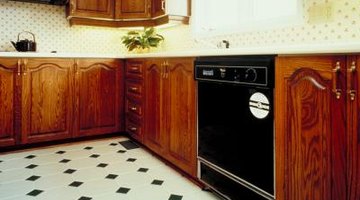How to Skim Coat a Subfloor for Linoleum
Linoleum flooring is a durable, inexpensive option that is frequently installed in both kitchens and bathrooms due to its resistance to water and easy maintenence. If you are installing new linoleum, the first step is to properly prepare the subfloor. Whether the subfloor is plywood or concrete, you must fill in any depressions by skim coating it with a special patching compound. Depressions that remain will show through on the linoleum, giving the flooring a wavy appearance.

Step 1
Vacuum the entire subfloor thoroughly to remove all traces of dirt and dust, which can interfere with the skim coat adhesion. Use a crevice tool or a hose to remove dirt from the corners and edges of the subfloor.
Step 2
Fill a bucket with one gallon of water and dip a sponge mop into it. Wring out the mop thoroughly and lightly mop the entire surface to remove remaining dust particles. Wait until the floor dries completely, which may be overnight.
Step 3
Open a can of latex floor primer. Paint the primer with a brush onto the edges of the subfloor where it meets the wall and into all of the corners to ensure they are completely covered.
Step 4
Pour the remainder of the primer into a paint tray. Screw an extension handle onto a paint roller and insert the roller into the primer until saturated. Roll the primer onto the surface of the subfloor until no part of the floor remains visible. Allow the primer to dry overnight before proceeding.
Step 5
Open a bag of self-leveling compound powder and pour it into a 5-gallon bucket. Add the amount of cold water to the bucket as instructed by the bag directions. Install a paddle mixer onto a drill and put on a dust mask. Squeeze the drill trigger to mix the compound thoroughly for two to three minutes.
Step 6
Set the drill aside and pour the mixture over the subfloor in pools. Spread the mixture out into a 1/4-inch-thick skim coat using a wide trowel. If there are any deep depressions, add more compound to those areas.
Step 7
Proceed with the linoleum installation after four hours, when the self-leveling compound is cured and hardened.
References
Writer Bio
Kimberly Johnson is a freelance writer whose articles have appeared in various online publications including eHow, Suite101 and Examiner. She has a degree in journalism from the University of Georgia and began writing professionally in 2001.
Photo Credits
- Jupiterimages/Photos.com/Getty Images
More Articles



